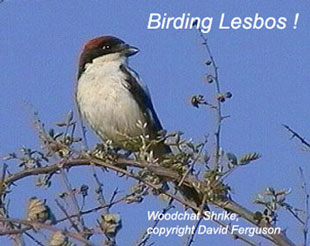This trip was a near replica of last year's. The only difference was that we picked up the car from the airport rather than wait for it to be delivered to the hotel which increased the birding time. Booking the car independently of the holiday was also cheaper. We stayed at the Vasso Apartments on the outskirts of Skala Kalloni, which is definitely the best town to stay in. We ate in the tavernas along the sea front. In a departure from last year we decided, on most days, to forego our self-made ham rolls made with yesterday's bread and patronise the baker's by the harbour. Everything was reasonably priced.
Books and maps
The field guide we used was the
Collins Bird Guide. This is a very good book but it failed on two crucial species: Finsch's Wheatear and Upcher's Warbler.
A Birding Guide to the Greek Island of Lesbos by Richard Brooks is essential. It describes all the sites mentioned in the report apart from the Napi Valley which was not discovered until 1999. The map we used was Toubi's 1:120,000. It is sometimes inaccurate and it omits several roads (such as the Potamia Valley road to Anemotia).
Weather
It was dry and sunny every day. The temperature started in the low 20's and rose by the end of the week to the high 20's. There was a strong NE wind on the first few days which died away towards the end of the week. Raptor watching became difficult by the end of the week because of the heat haze. There were less birds too, presumably because they were flying higher.
Day by day
4th May 2000
On a sunny, breezy day we drove south from the airport for a little seawatching. We found about 30
Cory's Shearwaters and about 10
Yelkouan Shearwaters fairly close in. In the roadside scrub was an
Orphean Warbler with food.
Near Agios Georgois we found a
Lesser Grey Shrike, one of only two seen during the week and three
Whinchats. Our next stop was Charamida Marsh near Loutra Korfou where we saw
Red-rumped Swallows,
Black-eared Wheatears, a
Corn Bunting,
Hooded Crows, a
Black-headed Bunting and an
Olivaceous Warbler - all common Lesbos birds. A
Little Bittern flew up from the marsh. We drove around the peninsula then tried to find the unsurfaced road that would have allowed us to avoid Mytilini. We failed on this and we had to negotiate the labyrinth of the capital.
The reedbeds at Dipi Larssos proved difficult to bird due to poor access. However we did see
Nightingales,
Reed Warblers,
Great Reed Warblers,
Cetti's Warblers, two
White Wagtails, a
Blue-headed Wagtail and several
Serins. Waders on the river consisted of a
Common Sandpiper,
Green Sandpipers,
Little Stints, a
Ringed Plover and a
Little Ringed Plover. There was also a
Little Egret, and a
Grey Heron. A
Common Buzzard flew over the main road as we drove to Kalloni.
We viewed the Skala Kalloni Salt Pans from the main road. One each of ringtail
Hen and
Montagu's Harriers quartered the fields to the north of the road while a
Red-footed Falcon flew past. On the pans were
Ruffs,
Little Stints, a
Greenshank, a
Kentish Plover,
Greater Flamingos and
Avocets.
Up till now the birds had been fairly routine for Lesbos but the sight that greeted us when we reached the East River was amazing, even by Lesbos standards. By the road bridge we could see 52
Glossy Ibises,
Little Egrets,
Squacco Herons, a
White Stork, a
Black Stork, numerous
White-winged Black and
Whiskered Terns,
Little Terns and a
Common Tern - all at close range. The Kalloni 2 Pool, by comparison, seemed tame with its seven
Squacco Herons, two
Little Bitterns and
Black-winged Stilts. After we had checked into the apartment we found
Spanish Sparrows in one of the adjacent fields.
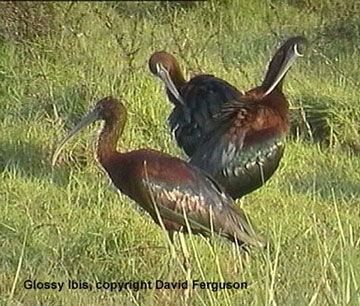 5th May 2000
5th May 2000
We were walking to the car just as the sky was lightening when about 60 pratincoles flew east over our heads. They were presumably the
Collared Pratincoles that were found in the field at the back of the salt pans later in the day. We drove to the East River where we found
Wood Sandpipers,
Little Stints, two
Temminck's Stints,
Ruffs,
Little Ringed Plovers, a
Greenshank,
Glossy Ibises, six
Red-footed Falcons, a
Turtle Dove and a
Whitethroat.
Olivaceous Warblers were abundant.
Last year taught us that the migration tended to be early in the week so we decided to drive to the migration hot-spot of Faneromeni via Grand Canyon and the Ipsilou Monastery.
At Grand Canyon the birding continued with
Long-legged Buzzard, a male
Levant Sparrowhawk, a
Hoopoe, a
Cirl Bunting, a
Blue Rock Thrush,
Cretzschmar's Buntings, a
Middle Spotted Woodpecker and two
Linnets. Last year's singing
Rock Thrush and
Olive-tree Warbler were not in evidence.
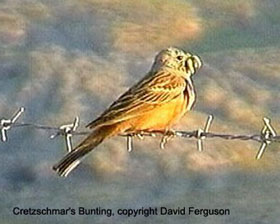
We did a stop at the Perivolis Monastery which gave us a
Spotted Flycatcher. We also saw two
Alpine Swifts. In the "Isabelline Triangle" we found two
Isabelline Wheatears and a
Red-footed Falcon sitting on a rock.
At the Ipsilou Monastery we had good views of two
Rock Sparrows while the trees on the southern slope were full of
Wood Warblers and
Pied Flycatchers. There was also two
Blackcaps, a
Willow Warbler and - uncommon in Lesbos - a
Nuthatch.
Red-rumped Swallows and a
Crag Martin were flying around. In the valley below we could hear and see
Golden Orioles. Lesser Spotted Fritillary was a good butterfly.
As we approached Sigri we saw several
Lesser Kestrels flying close to the road. We stopped the car, leapt out and received superb views of about six as they flew around us. On the way to the Faneromeni ford we saw a
Woodchat, two
Whinchats,
Bee-eaters and a
Golden Oriole. At the ford itself was a female
Red-breasted Flycatcher and a very tame
Temminck's Stint. On the way back to Sigri we saw two female
Hen Harriers.
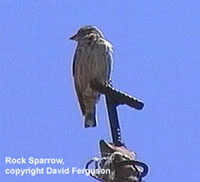
We had been told by some birders at the ford that the ford on the Sigri-Eressos road held a
Citrine Wagtail while nearby was a
Finsch's Wheatear. We had tried this road last year and given up because of its condition, but, apparently, it was now passable even in a two-wheel drive car.
As we rattled along this road (really a rocky cart-track) it became obvious that heavy migration was taking place. There were small parties of
Blue-headed Wagtails alongside the road, while
Spotted Flycatchers and
Whinchats were everywhere. Then, what had been a good day became an extraordinary one. As we were bouncing along towards the ford, three birds dropped out of the sky and landed among the rocks on the left-hand side of the track. One was perched on the top of one of the larger rocks about 20m from the road. We stopped and got the bins on it. JR was in the front passenger seat so he had the worst view but MC and DF had a clear view of a slim Redstart-like bird, plain grey with a blackish tail. MC was calling out "
Blackstart!" while DF was still wondering what he was looking at. Then the penny dropped with him and mild pandemonium ensued. If they had been super-cool, MC and DF would have videoed the bird before getting out of the car, but they didn't. We all got out of the car - a big mistake. The bird gave good views but flew up the hillside before anyone could video it. We spread out as we climbed the hill in search of it. The wind was now very strong and the sun was getting lower so that viewing conditions were becoming difficult. There were
Spotted Flycatchers all over the hillside and JR found a small group of
Wood Warblers and a
Tawny Pipit in the low scrub. DF found the
Blackstart high up the hillside and got a good view as it flew from a rock, fanning its black tail. It flew almost to the skyline and landed. DF called the others but we did not see it again. During the hour or so that the search took a couple of birders' cars drove past, but only one birder helped us in the search. If accepted, it will be the first record for Europe.
We drove on to the ford, seeing a
Montagu's Harrier and a
Red-backed Shrike on the way. At the ford, we obtained stunning views of a male
Citrine Wagtail walking on the floating vegetation. There was also a
Masked Shrike and an
Eleonora's Falcon. Beyond Eressos we saw our first
Short-toed Eagle of the trip.
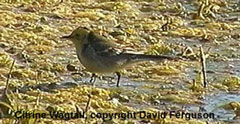 6th May
6th May
Dawn at Kalloni 2 Pool gave us
Whiskered and
White-winged Black Terns and a
Little Bittern. We then paid our first visit to the sheep field at the back of the salt-pans. We were surprised at how dry it was compared to last year. We found
Short-toed Larks, about 10
Red-throated Pipits, a
Zitting Cisticola, a
Short-toed Eagle, a
Marsh Harrier and
Eleonora's Falcons. On the pans were a
Little Grebe, a
Great White Egret and a
Purple Heron. There were two
Great Crested Grebes on the sea. By the workings were 20+
Bee-eaters.
Back at Skala Kalloni, while waiting for the baker to bake his pies, we found a 2nd-summer
Audouin's Gull in the harbour.
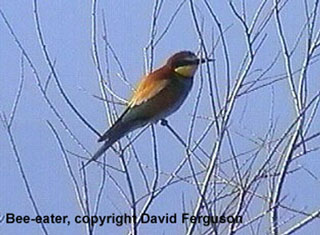
Today we were going to explore the north coast and the Napi Valley. This site is usually accessed by taking the right fork just south of Napi. The road is shown on the map; it eventually joins the Kapi-Madamados road. It begins as a wide surfaced road but soon becomes the usual Lesbos gravel. The valley is best known for its
Olive-tree Warblers which are in an olive grove on the left about 1 km past a farm which is on the right. The road then climbs and gives good views of the east side of the island. Approaching the site from Napi is straightforward. Approaching from the other direction - which is what we did - is less easy.
On the sea between Petra and Molivos was a
Shag, while in the scrub were a
Ruppell's Warbler,
Orphean Warblers and a
Subalpine Warbler. We walked out to a point about 2km west of Molivos and found a pair of
Lanner Falcons giving great views as they flew over the sea. 10
Shags were well out to sea. Near Vafios we saw two
Hobbies and an
Eleonora's Falcon.
We found the unsurfaced road into the Napi valley with some difficulty. The standard map of Lesbos is often inaccurate and in this case the road is much nearer Kapi than indicated. On one of our abortive tries up a dirt track we found a
Short-toed Treecreeper and two
Ravens.
The track took us through open woodland where we saw
Mistle Thrushes and a
Rock Nuthatch.
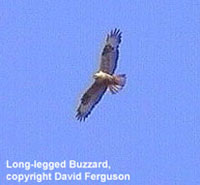
At the raptor watch-point we saw a
Long-legged Buzzard and an immature
Bonelli's Eagle. In a field across the valley were 18
Red-footed Falcons. In the valley itself we came upon a small group of birders who were looking for
Olive-tree Warblers. We heard three but found them very difficult to see.
Subalpine Warblers were feeding young nearby.
7th May
Today we decided to try the Inland Lake and the Potamia Valley. The lake produced a male and two female
Little Crakes, two
Black-crowned Night Herons, and
Great Reed,
Reed and
Sedge Warblers. The Potamia Valley began with a
Woodchat within a few feet of the car. We parked and joined a small group of birders looking for
Olive-tree Warbler. We failed on the warbler but did see a pair of
Masked Shrikes, a female
Cirl Bunting feeding young and a
Sombre Tit. Butterflies present included Scarce Swallowtail, Eastern Festoon and Clouded Apollo. We then drove up the valley.
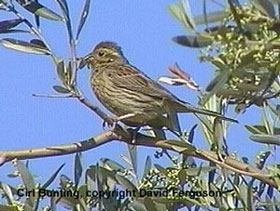
On the bendy section of the road, DF, who was driving, saw a large raptor out of the corner of his eye. An emergency stop in a handy layby and we were out of the car. By some miracle the bird came over our heads where it circled for a few minutes allowing MC and DF to video it. The bird was a
Golden Eagle, only the 8th record for the island. We then carried on up the road until we found a suitable raptor watch-point. An hour's watching produced five
Short-toed Eagles,
Long-legged Buzzards,
Common Buzzards, two
Honey Buzzards and two female
Levant Sparrowhawks, one chasing the other. Two
Woodlarks were singing nearby.
We drove on along the road just to see where it went. The answer was Anemotia. From here we could have gone to Vatousa or Kalloni, but we decided to retrace our steps to the Parakila Marsh. We tried for
Finsch's Wheatear but without success.
The Parakila Marsh turned up a
Common Snipe (brief dreams of Great!),
Squacco Herons and four
Glossy Ibises. We finished the drive at the West River where we found a
Stone Curlew, a
Kentish Plover and another
Eleonora's Falcon.
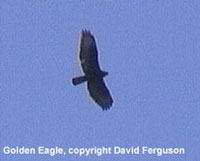
After dinner we drove to the
Scops Owl site just up the road from the apartments where we heard a Scops Owl and saw a Beech Marten. We also heard a
Barn Owl near the apartment.
8th May
We started at the East River where we saw a
Little Owl, a
Marsh Harrier, a
Purple Heron, nine
Black-crowned Night Herons, a
Greenshank and two
Curlew Sandpipers.
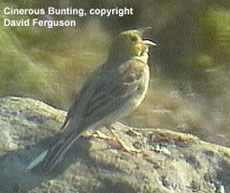
We then set off to the west for Cinereous Bunting. We had a site between Agra and Messotopos which we had found last year but we encountered a couple of tour minibuses a few kms before it. The birders were looking at a singing
Cinereous Bunting halfway up the hillside. This site is marked by a white building with 2 pillars at the front corners. At our site, which is marked by an EKO garage sign, there was another male.
Cretzschmar's Buntings were everywhere. We also found
Rock Sparrows at two sites and high in the sky were three
Alpine Swifts.
We returned to the Blackstart site but only found a
Tawny Pipit (the same bird?). In a clump of pines surrounding a small chapel 1km to the west of the ford we found a female
Collared Flycatcher (which needed careful separation from Semi-collared). Near the ford a group of birders were looking at a distant dark lump which they told us was a
Lesser Spotted Eagle sitting on a rock. It eventually took off to give us great views as it glided along the ridge. There was also a
Lanner Falcon, two dark-phase
Booted Eagles, a
Honey Buzzard,
Long-legged Buzzards and
Lesser Kestrels.
We left the ford to return home when we made our next major encounter. JR saw a female Wheatear perched on a rock in the dry stream which looked "different". We stopped, leapt out of the car and studied it from about 30m range. This time DF and MC had their camcorders ready and videoed the bird. It was plain grey and white with a hint of buff round the face. It did not look like one of the ubiquitous Black-eared Wheatears. We were still arguing about it after we had flown back home. It took a frame-by-frame analysis of the rather poor videos and much perusing of
The Handbook of Bird Identification and BWPC to satisfy us that we had seen a
Finsch's Wheatear. It has to be said that the Collins failed on this one. This bird may have been the bird seen earlier in the week (we didn't know it's sex). A birder we met had seen one by the Skala Sikamia - Eftalou Road so they are getting commoner or, more likely, people are looking out for them.
9th May
We began the day at the back of the salt pans, where we met a friend of ours, Gerry Marsh, who had just seen a
pelican land on the far side of the pans. Someone else said it was a Dalmatian and immediately caught our attention! We decided to drive round to see if we could find it. We parked down a track off the main road at the eastern end of the pans. We found the pelican almost immediately - and it was a
Dalmatian which was a tick for all of us. The through-the-scope-and-heat-haze video which DF managed to get was not the best, but it clearly identified the bird. As a bonus, behind the pelican were two
Spoonbills doing what they do best (heads under wings).
Back at the Kalloni 2 Pool a group of birders were looking for a
River Warbler in a roadside bush. As usual, it was pretty elusive but we managed brief views. On the beach was a
Great White Egret. We then set off to the east, to the highlands behind Agiassos.
At the water tank site we found a
Kruper's Nuthatch nest. Further along the road there is a track off to the left which wanders through the sweet chestnut forest. We had tried this last year for Eastern Bonelli's Warbler without success and we now repeated the performance. We did see and hear probable Bonelli's but could not get close. We also found
Robins,
Chiffchaffs, a
Song Thrush and six
Mistle Thrushes. The flowers were spectacular.
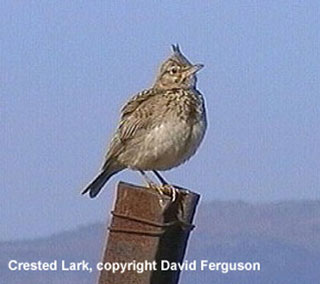
We dropped down to the coast at Skala Polychnitos where, at the salt pans, we encountered a
Tawny Pipit, three
Kentish Plovers and a
Greenshank. At Achladeri we found the
Kruper's Nuthatch nest after some difficulty, but the birds gave only brief views as they fed the young at the nest. At Derbyshire, we found eight
Ruddy Shelducks, two
Grey Plovers and a
Pintail. In the early evening, back at Skala Kalloni, we tried a
Middle Spotted Woodpecker site near the apartments. The nest was by the road and facing it. On the other side of the road was a convenient bench and wall which allowed birders to sit in a row while waiting. The views were brief as the birds fed young.
10th May
We tried the
Middle Spotted Woodpecker site again and were rewarded with good views. We had heard that the
Rufous Bush Robins were back at their site near the East River where we had seen them last year. Here we encountered the largest group of birders yet who were being given the runaround by a very mobile Rufous Bush Robin. However, we managed good views of the bird without too much difficulty.
After this we drove up the Napi Valley to try for
Olive-tree Warbler again. We obtained views, but they were no better than before. However, another birder found a
Hawfinch which gave us superb views. There was obviously a nest nearby as it was carrying a beakful of food which was particularly interesting as the species has apparently not been proven to have bred on the island! A perched
Long-legged Buzzard, a
Masked Shrike and a
Hoopoe added variety. The last is a surprisingly uncommon bird in Lesbos. We also saw three
Woodlarks.
It was now hot, with a considerbale heat haze which hampered raptor watching, but a session at the raptor watch point did produce another of the rather uncommon
Common Buzzards. We then dropped down to the Kapi - Madamodos road. On the unsurfaced road west of Skala Sikamias we crossed a concrete bridge where
Red-rumped Swallows were flying. We stopped to have a look at them. Almost immediately JR heard an unfamiliar song emanating from a tree by the stream. DF joined him in searching for the bird while MC wandered upstream. JR and DF had brief glimpses of a large pale warbler in the tree canopy which was unfamiliar to them. Consulting the Collins guide they tentatively settled on
Upcher's Warbler. About two hours later, after seeing enough of the bird in a series of brief glimpses they decided that Upcher's was correct. On returning home, it was interesting to find how much the field guides differed on this bird, with Jonsson being the least accurate. The Birding Images video was the most useful reference. Meanwhile, MC had returned to announce that he had heard a
River Warbler a hundred metres upstream; he had recorded the song on his camcorder. By the time JR and DF got to it, however, the bird was no longer singing. During the lengthy period of time all this took, several birders had stopped but had shown little interest in seeing the admittedly very elusive Upcher's. There have only been three previous records for the island (and Europe)!
11th May
Our last day. The
Spoonbills were still on the salt pans. At Derbyshire the
Ruddy Shelducks had increased to 11. We tried for Chukar on the peninsula to the south of the airport but failed. It was a quiet end to an eventful week.
Comment
Although Lesbos is one of the most popular birding destinations in Europe, it is surprisingly under-watched. When we found our four big birds -
Blackstart,
Golden Eagle,
Finsch's Wheatear,
Upcher's Warbler - we were on our own. While watching the eagle and the wheatear we did not see another birder; we only saw a couple of birders when we were watching the other two birds. The bird tours tend to concentrate on the hot-spots so that the fords at Faneromeni and on the Sigri-Eressos road were fairly crowded, while Kalloni 2, which is next to most of the hotels, was watched all the time. But our lengthy raptor watches and our journeys along some of the island's rockier roads were without the company of other birders. There is almost certainly a lot more to discover.
click here for trip list and more photos.....
